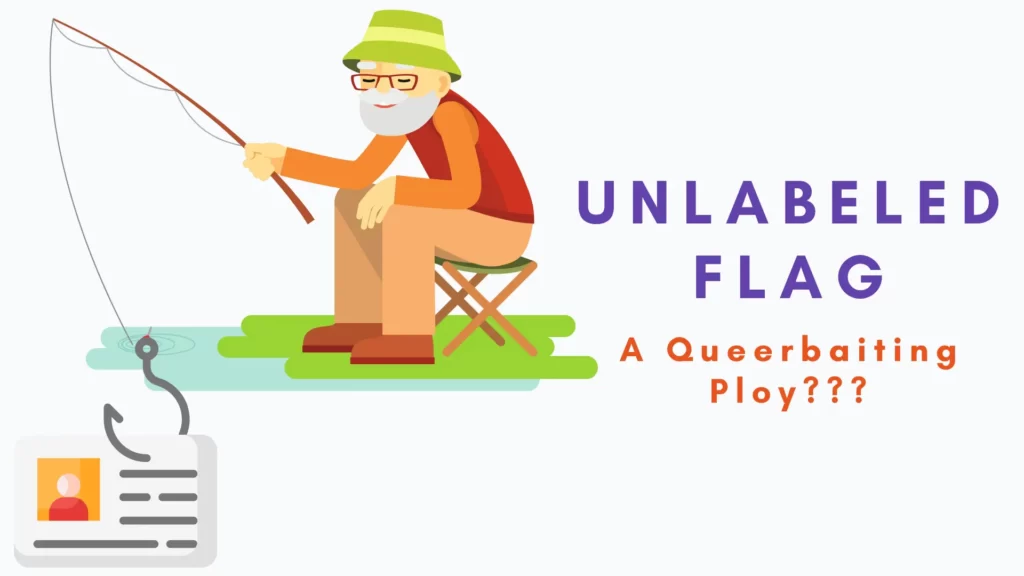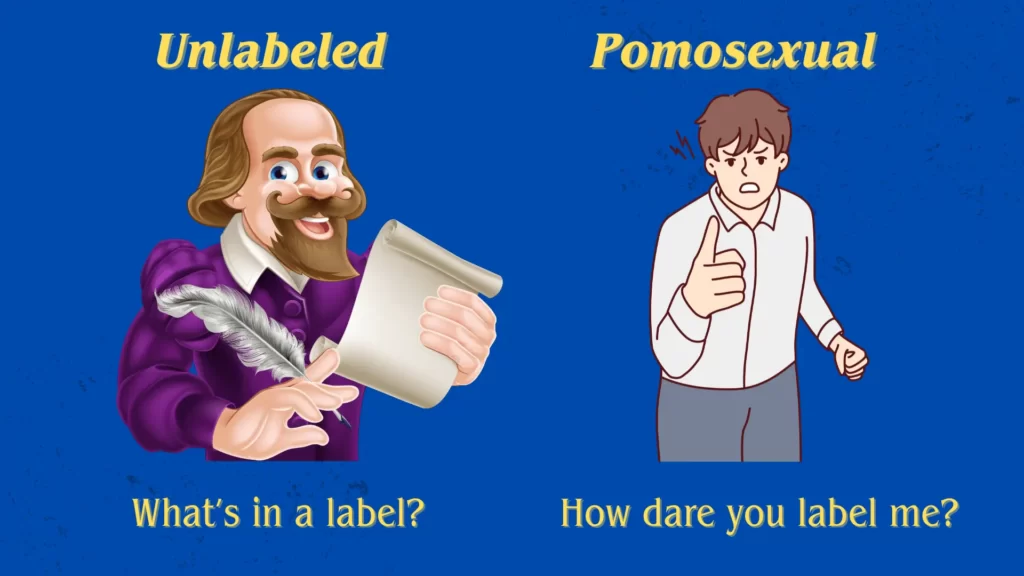
Introduction
In recent times, many young people have started identifying themselves as unlabeled, for they are not willing to be classified on the basis of their gender identity, sexual orientation, or any characteristic of their individuality that would confine them to a particular category, community, or nomenclature. The reason could either be that they feel misfit in the defined and available labels, or they feel that it is unnecessary for them to disclose their gender identity or sexual orientation.
Unlabeled individuals use the unlabeled flag, also known as the unlabeled pride flag, as their symbol. Just as the rainbow flag is an umbrella symbol of all communities that are together known as the LGBTQ+, the unlabeled flag is an umbrella symbol for all those who steer clear of any labels of gender identity, sexual orientation, etc.
Before we learn about the unlabeled pride flag and the unlabeled community, it is important to clear up the confusion between unlabeled and pomosexual.
Design and Origin of the Unlabeled Pride Flag
The unlabeled concept is rather novel, whose origins can be traced to online communities. It is quite natural that a symbol for representing the unlabeled should have originated on the microblogging site Twitter, which has been rebranded as “X”, because most of the discourse on gender identities and sexual orientation occurs on social media websites.
The unlabeled flag was designed by Twitter user @lwtroses on June 3, 2020. It seems that the user account that created the flag has since been suspended or deleted.

Made with Canva
The unlabeled pride flag consists of four stripes of different colors, namely green, white, blue, and orange, mentioned in order from top to bottom as they appear on the flag. It is worth noting that the green, blue, and orange colors used on the flag are pale or light.
It is understood that the users themselves explained the significance of each color; however, the original post containing this information has also been deleted as the user account was suspended.
Significance of the Colors on the Unlabeled Pride Flag
Light Green
The pale green color on the top stripe represents freedom. The significance may have been to represent freedom from any sort of labeling based on gender identity and sexual orientation.
White
The white color of the flag represents understanding. It signifies that unlabeled people understand the superfluity of labels and that it should be completely optional for people to use them.
Light Blue
The light blue color on the flag represents acceptance. It shows that unlabeled people accept their choice of staying clear of all sorts of labels of gender and orientation while, at the same time, accepting the choice of others to identify with a label of their preference.
Light Orange
The pale orange color stands for flexibility or adaptability, signifying the fluidity of unlabeled people across the gender and sexual orientation spectra.
Unlabeled Pride Flag Color Codes
The codes of the colors used in the unlabeled pride flag in Hex, RGB and HSL are:
Light Green
Hex: #e6f9e3
RGB: rgb(230,249,227)
HSL: hsl(112,65%,93%)
White
Hex: #fdfdfb
RGB: rgb(253,253,251)
HSL: hsl(60,33%,99%)
Light Blue
Hex: #dcf0f7
RGB: rgb(220,240,247)
HSL: hsl(196,63%,92%)
Light Orange
Hex: #fae1c2
RGB: rgb(250,225,194)
HSL: hsl(33,85%,87%)
History of the “Unlabeled”
The term ‘unlabeled’ or ‘no label’ was initially used in the lesbian community by members who did not wish to associate with or confine themselves to popular subcultures, such as butch, femme, etc. Did you know that the butch lesbian community also has its own flag? Find out more in our article on the butch lesbian flag.
Gradually, people from across the gender identity and orientation spectrum, who did not think it necessary to take up a label, began recognizing themselves as unlabeled.
Reasons for Identifying as Unlabeled
There are some compelling justifications for people to identify as unlabeled. For any individual, it can be any one or a mix of the following reasons for identifying as unlabeled:
Freedom to remain fluid
There are people who are conscious of the fluidity of their identity and consider it unfair to tie themselves down to one particular label only to change it after some time. They have come to acknowledge this fact and choose to celebrate the complexity of their identity.
Avoiding stereotypes
Categorization often leads to the creation of stereotypes that not only lead to discrimination but also lead people to develop a negative self-perception.
Societal norms
Some people are appalled at the idea of society making norms for their identity, which is a private matter for them. Therefore, they may stay away from labels as a way of signaling to society that it is a personal choice and the society’s norms and expectations about their identity and sexual orientation do not matter.
Privacy
Many individuals are not comfortable speaking about their identity in public and therefore, they may choose not to disclose it for reasons of privacy and to avoid getting judged or discriminated against.
This discussion brings us to the question – Is Unlabeled a Label?
Asking if unlabeled is a label is like asking if colorless is a color. Obviously, colorlessness is the absence of any color, a description of the state of having no color that should not be perceived as a color in itself.
Similarly, unlabeled is a description of the state of an individual having affiliation with no labels whatsoever. So, people who jump to define it as a label have grossly misunderstood the subject.
If unlabeled is not a label, why is there an unlabeled pride flag?
It is a misconception that flags and symbols represent labels only, especially in the context of LGBTQ+ pride flags. While it is true that flags represent labels, flags actually represent people and communities. It comes in handy when you have to network with people who are unknown to you or when you need something as a rallying point.
Therefore, it is again a misconception that if people use a flag, they somehow become labeled ex de facto.
Is the invention of an Unlabeled Flag a Queerbaiting Ploy?

It is not queerbaiting, as your choice of not going by any labels cannot be queerbaiting. It is you who have chosen not to be identified by any labels of gender identity or sexual orientation. A flag has been invented as a symbol for all such people who do not go by any labels to represent this choice of theirs. How can that symbol be a queerbaiting ploy when all that you desire to achieve is to show the world that you are not interested in labeling yourself and prefer to keep your gender identity and sexual orientation to yourself?
Read also: The issue with Rainbow Capitalism
Who can identify as Unlabeled?
Anyone, regardless of their placement along the gender identity and sexual orientation spectrum, can identify as unlabeled. The only criteria is that the individual does not wish to identify with any labels, either for reasons of privacy or because they feel that they do not fit into the description of any labels.
Unlabeled Vs Pomosexual
The term pomosexual refers to individuals or concepts that reject or resist traditional categories and labels of gender identity and sexual orientation. People may also use it to critique the rigidity of the labels of sexuality and gender identity within LGBTQ+ communities.
You may be wondering if the description of a pomosexual matches exactly with that of an unlabeled individual. Well, to some extent, yes, but not quite.

People who call themselves unlabeled have the opinion that it is unnecessary to create a label for the people who do not conform to the labels of gender identity and sexual orientation and accordingly avoid them, whereas a pomosexual person identifies with a label of community that disapproves of such labels and criticizes and rejects them altogether.
Therefore, while both are clear about the superfluous nature of labels based on gender identity and sexual orientation, the difference is in the stance they take on the matter. The unlabeled are rather indifferent about it and think that this opinion of theirs should not be identified as a new label; however, the pomosexuals identify as a label that disapproves of and rejects such labels.
Are Unlabeled persons part of the LGBTQ+ community?
This question again tries to pigeonhole an unlabeled individual. The answer to this question is that it is up to the individual to decide whether they wish to be an unlabeled person from the LGBTQ+ community.
Typically, if a person does not identify with any label and feels misfit when described as cisgender, heterosexual, alloromantic, heteroromantic, or any such labels associated with straight people, they may identify as an unlabeled person from the LGBTQ+ community. The choice is entirely theirs.
Read also: Sapphic Pride Flag
Read also: The Straight Ally Flag – A useful symbol or pointless accessory?